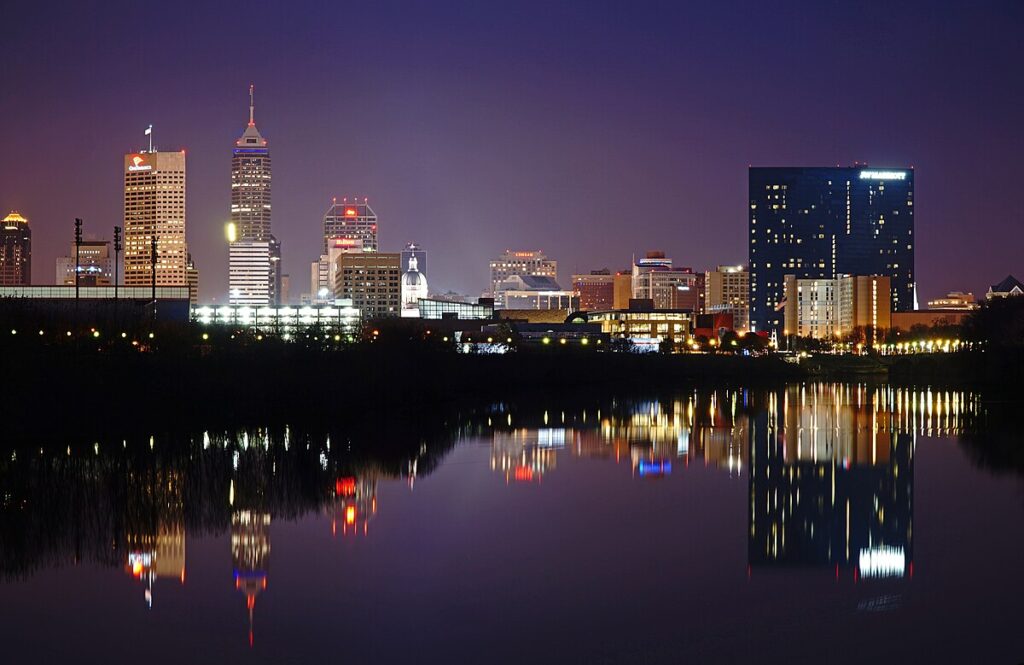
Moving to Indianapolis, Indiana: A Comprehensive Relocation Guide
Considering moving to Indianapolis, Indiana? This state capital and largest city of approximately 874,000 residents offers Midwest affordability with big-city amenities. Here’s your comprehensive guide to relocating to Indianapolis in 2025.
Demographic Profile to Consider If Moving to Indianapolis:
Indianapolis, the Marion County seat and Indiana’s capital, stands as the state’s largest city and the nation’s 16th most populous. The median age of 34 years reflects young professionals and families. The consolidated city-county government known as Unigov has operated since 1970. The population includes diverse demographics with 54 percent white, 28 percent African American, and growing Hispanic and Asian communities. The city’s official slogan, “Crossroads of America,” reflects its central location and transportation heritage. Indianapolis features distinct neighborhoods from historic downtown to sprawling suburban developments. The metropolitan area exceeds 2.1 million residents.
Cost of Living to Consider If Moving to Indianapolis:
Indianapolis offers exceptional affordability among major American cities. Median household income approximates $63,000, while median home values remain well below coastal metropolitan areas. The poverty rate of approximately 16 percent exists alongside thriving middle-class neighborhoods and growing professional sectors. Housing costs, utilities, and overall living expenses provide significant value compared to Chicago, coastal cities, or other major metros. The combination of affordability, employment opportunities, and urban amenities makes Indianapolis increasingly attractive to young professionals, families, and businesses seeking value with quality of life.
Economy and Job Market:
Indianapolis boasts diversified economy including healthcare, advanced manufacturing, logistics, financial services, and technology. Major employers include Eli Lilly and Company, Indiana University Health, Community Health Network, Salesforce, and Rolls-Royce. The city serves as regional headquarters for numerous Fortune 500 companies. The logistics and distribution sector thrives due to central location. Life sciences cluster grows around Eli Lilly and associated research institutions. Real GDP growth projections for 2025 exceed 3 percent. Unemployment remains low around 3.5 percent. Downtown redevelopment and $9 billion in capital improvement projects support economic expansion. The economy benefits from diversification and continued corporate relocations.
Education:
Indianapolis Public Schools serves urban core students through numerous schools with varying performance. Township school corporations including Warren, Pike, Wayne, and Washington serve different areas with generally stronger outcomes. Private schools and charter schools supplement public education with diverse options. Butler University, IUPUI (Indiana University-Purdue University Indianapolis), and Marian University provide higher education. Indiana University School of Medicine, the nation’s largest medical school, operates in Indianapolis. Ivy Tech Community College offers vocational training. The educational infrastructure supports workforce development and provides options for families prioritizing academic achievement.
Recreation and Lifestyle:
Indianapolis offers extensive recreation and cultural amenities. The Indianapolis Motor Speedway hosts the Indianapolis 500, the world’s largest single-day sporting event. The Indianapolis Colts (NFL) and Indiana Pacers (NBA) provide professional sports entertainment at Lucas Oil Stadium and Gainbridge Fieldhouse. The Indianapolis Indians (minor league baseball) play at Victory Field. White River State Park downtown includes the Indianapolis Zoo, Eiteljorg Museum, and Indiana State Museum. The Indianapolis Cultural Trail connects neighborhoods with bike and pedestrian paths. Mass Ave Arts District, Fountain Square, and Broad Ripple offer dining, entertainment, and nightlife. Numerous parks, golf courses, and trails support outdoor recreation. The city hosts major conventions and events year-round.
Healthcare and Services:
Indiana University Health, Community Health Network, Eskenazi Health, and Ascension St. Vincent provide comprehensive healthcare with multiple hospitals, specialized centers, and extensive primary care networks. IU Health Methodist Hospital and IU Health University Hospital rank among the nation’s top hospitals. The Indianapolis medical community includes teaching hospitals, research facilities, and specialized treatment centers. Healthcare sector employs over 100,000 workers regionally. Healthcare quality, research capabilities, and accessibility support metropolitan population and attract medical tourism.
Transportation:
Indianapolis sits at the intersection of multiple interstate highways. Interstate 65 runs north-south, Interstate 70 east-west, and Interstate 69 northeast, with Interstate 465 circling the city. IndyGo operates fixed-route bus service including the Red Line bus rapid transit. IndyGo provides public transportation throughout Indianapolis and Marion County. The Indianapolis International Airport, located southwest of downtown, offers nonstop flights to major domestic and international destinations. The city’s central location provides convenient driving access to Chicago, Cincinnati, Louisville, and St. Louis. Bike infrastructure continues expanding with trails and protected lanes.
Conclusion:
Moving to Indianapolis in 2025 provides access to major American city with exceptional affordability, diversified economy, and Midwest quality of life. The combination of employment opportunity, cultural amenities, professional sports, affordable housing, and central location makes Indianapolis increasingly attractive for families, young professionals, and businesses seeking value with big-city conveniences in Indiana’s capital and economic heart.

